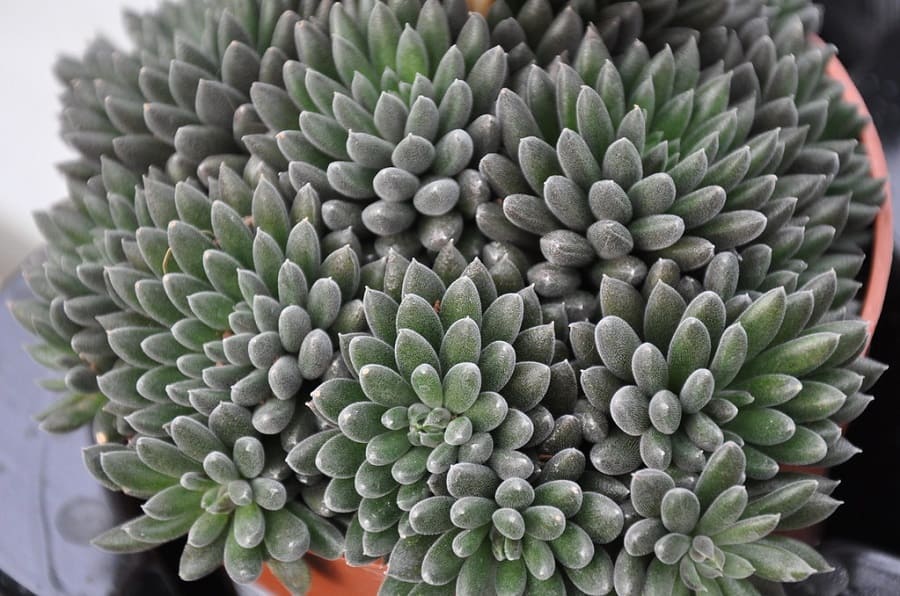Sinocrassula yunnanensis (Chinese Jade) is a small succulent with stems that are up to four inches long.
The leaves are arranged on a short rosette-shaped stem. The leaves can grow to approximately 4 cm in diameter.
The leaves are flat on one side and rounded on the other, and covered with short, fine hairs.
This wired-looking succulent plant is a monocarpal plant, which means it blooms and right after it dies.
This succulent produces long stems with a beautiful white flower.
Sinocrassula Yunnanensis Care:
Sinocrassula yunnanensis is easy to care for and excellent for beginning gardeners.
This succulent usually doesn’t give any problem, but there are many things that we have to take into account to enjoy it to the fullest.
Temperature
For the optimal growth of your Sinocrassula Yunnanensis the temperatures should always be warm.
The ideal range is between 20°C/68°F to 35°C/95°F. It tolerates low temperatures as long as the substrate is completely dry.
The combination of cold with humid environments causes stem and root to rot.
Substratum
It requires a substrate with excellent drainage.
It is recommended to provide a substrate composed of coarse sand, earthworm humus, and some rocks of different proportions.
The substrate must dry quickly, and it cannot be a substrate designed to hold moisture for long.
You can also mix the universal culture substrate with perlite in equal parts. If you cannot obtain this, you can use washed river sand or clay.
If you want to simplify your life, you just have to buy a specific substrate for cacti and succulent, and believe me, your Sinocrassula Yunnanensis will grow perfectly.
Illumination
Outdoors, in full sun or in half shade. It can also be kept indoors if it’s placed in a room with a lot of natural light.
If you have it in full shade, your Sinocrassula Yunnanensis will not grow properly.
Remember that succulents come from tropical areas; they like the sun and heat.
Watering
This is one of the most important cares, so pay close attention.
Always keep in mind that succulents can recover more quickly from a lack of irrigation than from an excess of irrigation.
Irrigation should be relatively poor.
It should be watered twice a week during the summer, while the rest of the year a watering every 10-15 days will suffice.
If you have a plate underneath, you must remove the water that remains after ten watering minutes.
If where you live you have a long and intense winter, it’s best to water once a month during this season.
Before watering your plant, always check that the substrate is completely dry. This will help you avoid overwatering it.
Diseases
Although succulents are usually very hardy plants, certain pests can attack them like the red spider and the cochineal.
To eliminate this pest, you can use insecticide for pest.
Transplant
Like all plants, they need to be transplanted periodically during spring.
When transplanting is a great opportunity to monitor the state of the roots.
For transplanting, use compost for cacti add coarse sand or perlite in the measure of 2: 1.
The ideal time to transplant your Sinocrassula Yunnanensis is every 2 to 3 years or when it no longer fits in the pot where you have it. The new pot should be 3 to 4 cm larger than the plant.
If you pruned the roots, you should wait at least a week before watering your Sinocrassula Yunnanensis, all in order to give the roots time to heal.
Propagation
The fastest way to get a new specimen is to multiply it using stem or leaf cuttings.
Stem cuttings: just cut a branch of interests, let the wound dry for a week and plant it in a pot. In fifteen days, it will begin to emit roots.
Leaf cuttings: fill a pot with substrate and place the leaf on top, without almost covering it. In a week, it will start to take root.
Pruning
Pruning is essential for the esthetics, multiplication, and branching of the plant.
It should be done only on grown plants.
Fertilizer
The fertilizer should be applied only during the spring and summer.
It must be fertilized with a liquid fertilizer for cacti.
